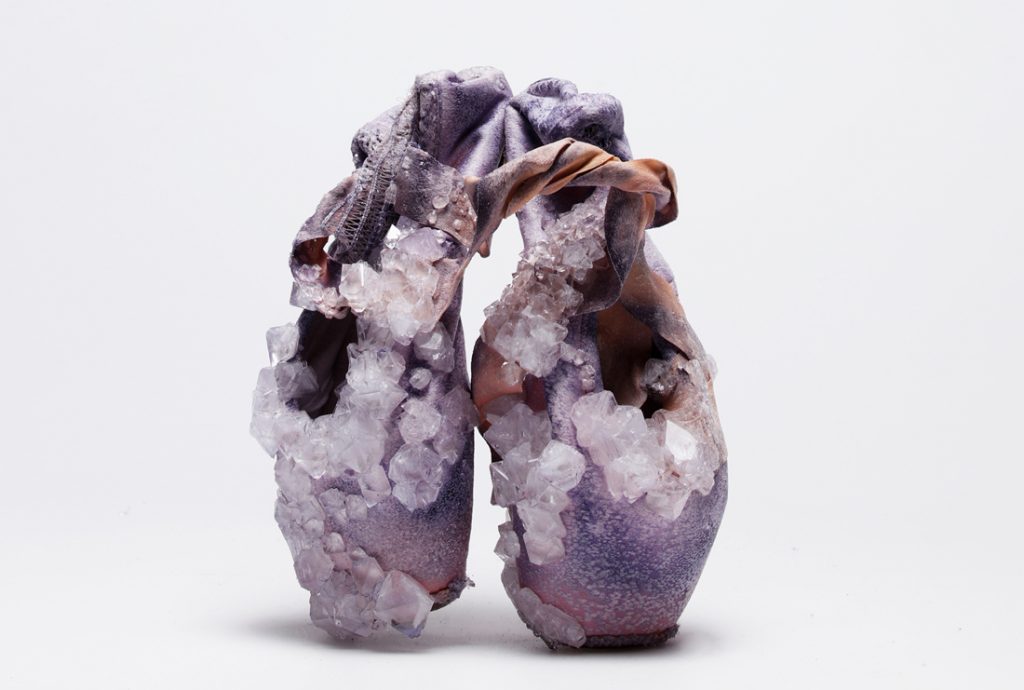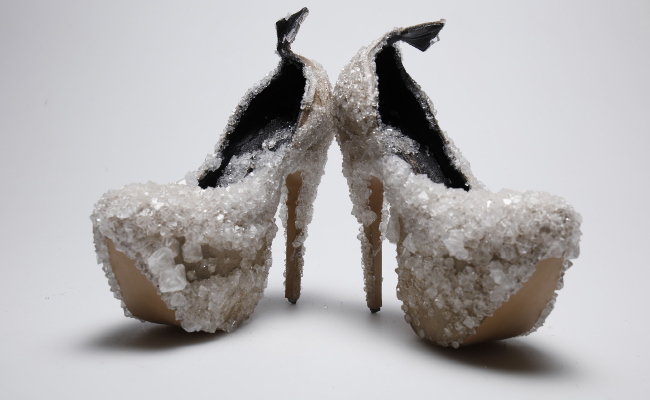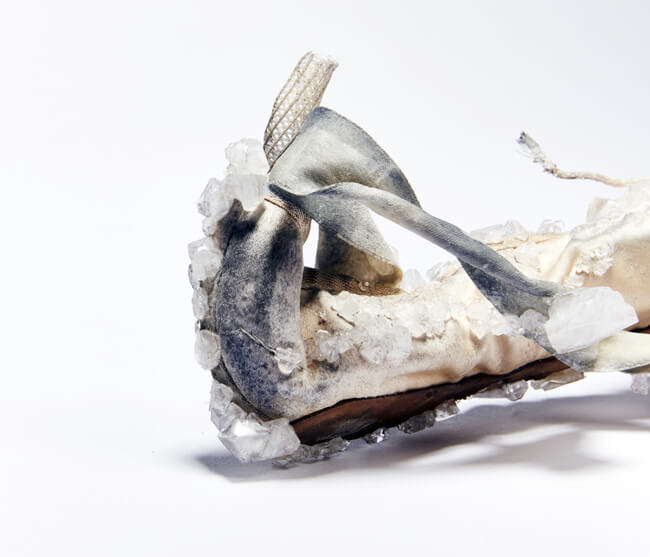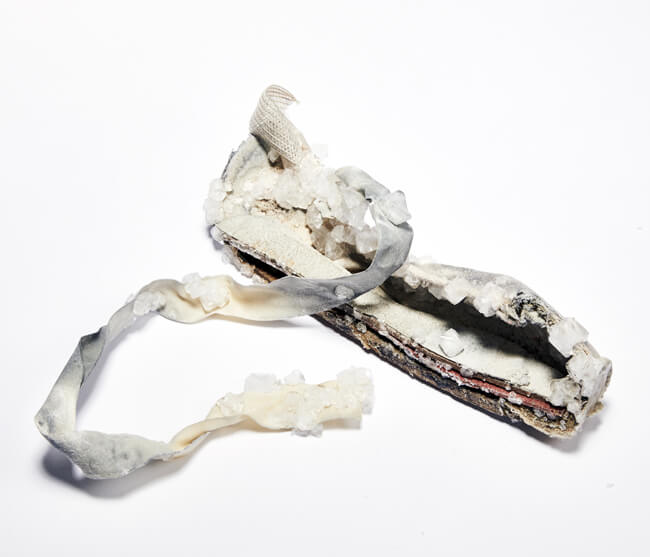Interview by Tina Gorjanc

In the past couple of years, the discipline of material innovation has seen an increasing number of interdisciplinary collaborations, which are producing new exciting solutions for current material problems present in today’s society. This movement and interest in future material exploration is especially noticeable when it comes to designing with the bio-based matter. Textiles-focused designers are therefore reclaiming the human body as a new source that can produce their own base substances for commercial products.
Alice Potts, a recent graduate from the Royal College of Art’s Fashion Womenswear course, believes that in the future, our bodies will not just be able to emit raw materials, which can be later used for production, but rather, she advocates that they are going to be able even to go as far as secreting their own fashion.
This concept, which was not even that long ago regarded as fiction, is now on the borders of reality, and her most recent project Perspire acts as a clear advocate for it. Over her two-year’s stay at the RCA, Alice researched ways to use sweat to design and produce accessories. This work has resulted in her producing a visual representation of the unseen beauty of how much people perspire aims to promote and inspire more creatives to aspire to fulfil the design role Alice has decided to persuade herself: materials research focussing on biomaterials and their applications within the fashion industry with the aim to create a new, sustainable alternative future.
The designers’ background education is the perfect example of the multidisciplinary approach to new design methodologies mentioned earlier in this article. Her knowledge in maths, chemistry and psychology, which she acquired through her earlier education, enables her to make sense of the equations and logic behind the academic subjects. She, therefore, tries to apply those principles to other platforms of creativity and design where she feels they are still very much underrepresented.
Over her nine-month experience called the Biodesign Challenge, which was provided by the University to some of the Fashion Womenswear students, Potts got introduced to bio-based materials and from there, she progressed to experiment with bioplastics. This new interest of hers resulted in her gaining contact with scientists at the Imperial College of London (the institution is a common collaborator with the RCA), which besides greatly benefiting Potts’ research, has also later gained ground for her to be awarded a fellowship programme with Onassis Cultural Centre in Athens, Greece.
This opportunity is providing the designer with tools and knowledge to develop further her current work, looking specifically into potential opportunities application for her collection to either continue to be situated in the fashion industry or explore a more biomedical route.
The fashion industry is still, in fact, one of the most polluting industrialised areas of our market today, with a variety of different areas within it begging for crucial and throw change. The more utopian overview of the problem promoted by material innovators seems to focus the attention on the current downsides within the production processes to be looked upon more as big design opportunities for creating change in the areas of our everyday life instead of keeping surrendering to the fact that the sustainability of our planet is doomed.




For those that are not familiar with your background (maths, science and fashion), could you tell us a bit about how and when did the interest in biomaterials come out?
Starting back in my A levels, I’d never exactly known which path I wanted to take. I studied a mixture of Math, Chemistry, Psychology and textiles, focusing on the areas that interested me, not allowing myself to be limited by one area or one direction. The equations and logic behind the academic subjects always made sense to me but had never been pushed to the same level of creativity and design. I then went to study fashion at Norwich University of the Arts, where I did my BA in womenswear. Having no background in fashion, I created my own rules and ways of approaching Design using my background to apply my way of thinking.
It was only until I took part in a 9-month project in my first year at RCA called the BioDesign Challenge that was taught by Helene Steiner, who introduced me to biomaterials. She taught me so much, introducing us to such a variety of people from all different backgrounds, and completely changed the way I thought but also finally gave the way I work a place that felt like it fitted in.
What are your aims as a fashion designer and material researcher?
My aims are to introduce a new way of designing to other designers but also to change the minds of consumers. Fashion always has a bad reputation for being the second most polluting industry with fast fashion and overproduction.
However, I don’t believe it can just be blamed on designers but on consumers for mass consumption. Where in a world of over-consumption where 1.3 billion tons of textiles are wasted a year. I aim to show people that there are other ways to work but also to bring people together and encourage a multidisciplinary direction of work.
In your project Perspire you use ‘the body’s natural sweat to grow crystals, with each one growing individually to the person, already able to detect levels of urea, estrogen and sugars’. What is the intellectual process behind this project?
At Imperial College, we used Chromatography which is an analytical technique commonly used for separating a mixture of chemical substances into its individual components so that the individual components can be thoroughly analysed. This gave us a chromatograph of each individual molecular build showing peaks that indicated a certain molecule.
The ID was predicted and found using the NIST database. NIST is a site that provides the chemical and physical properties of molecules. However, the molecular ID found is just a prediction result. To prove this, the analytical work required to be done is to purchase the commercial standard of the metabolite ID found, followed by GC/MS analysis, the same way as how the sweat samples had been analysed.
As a recent graduate from the RCA, London. What directions do you see taking your work into?
I’ve currently started a fellowship programme with the Onassis Cultural Centre in Athens, Greece. They are supporting me to continue my research and looking into the development of my current work. There are a lot of opportunities for the Collection, whether it stays in fashion or goes down a more biomedical route. I’m hoping with more research and collaborations with other disciplines that, it can be developed into a variety of areas. I would like to focus on fashion as it is one of the most polluting industries but also has a huge opportunity to change.
Solitude or loneliness, how do you spend your time alone?
I always spend my time researching and thinking. My brain is constantly on overdrive, with thousands of thoughts always going through my head. That’s why I always have to have a notebook with me to jot down my ideas, thoughts or concerns.
I’m terrible at sitting still for more than an hour as I always want to be surrounded by people, talking, learning and experiencing. I actually find the time I do have on my own the hardest parts of the day.
One for the road… What are you unafraid of?
I think I currently can’t allow myself to be either afraid or unafraid of all that is happening. The good and the bad thing about the work I produce is that there is no current industry for it, and Biomaterials have only just started to be further developed, so for me; the whole future is unknown. For this reason, I have to adapt to being unafraid as there is no clear path I can take but thousands of unknown routes I could go into.





